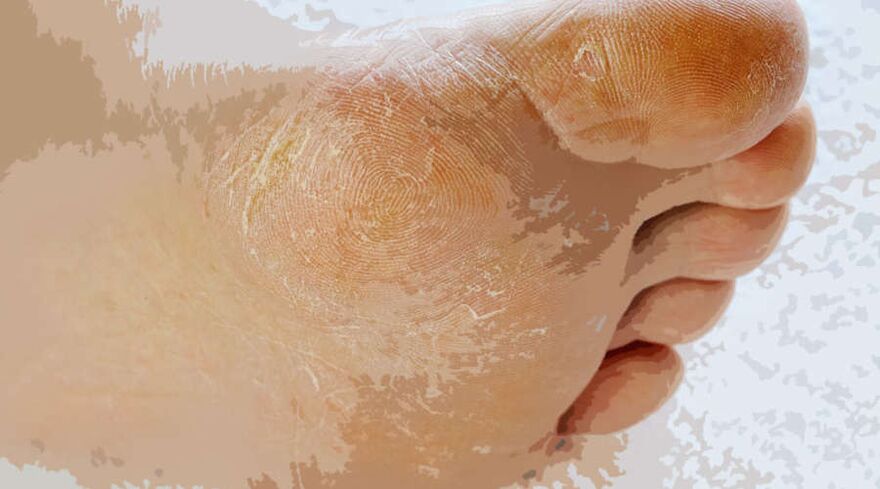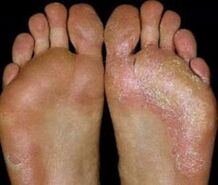
Mycosis of the feet (ICD code 10 B35. 3) is a fungal infection of the skin on the legs caused by parasitic dermatophytes. It occurs in around 20% of adults. Infection occurs through microtrauma, scratches, abrasions, wounds. The development of the disease is promoted by wet feet, diabetes mellitus, and weakened immunity.
In people with endocrine disorders and immunodeficiency states, the prevalence is 50%. More often the disease proceeds in a chronic form with alternating periods of remission and exacerbations. In 40-50% of cases, mycosis of the feet causes onychomycosis or fungal infection of the nails.
Where and why does the infection occur?
Mycosis of the feet is a contagious disease that can easily be transmitted through direct contact with a fungal carrier or through household items. For example, through shoes, socks, a towel, manicure accessories, rubber mats in the shower. In 70-95% of cases, Trichophyton red (Tr. Rubrum) is the causative agent of mycosis of the feet.
Usually, an infection occurs in public places with high humidity, where conditions are favorable for the pathogen to multiply and spread. These locations include swimming pools, public showers, saunas, water parks, and gym locker rooms. When a person infected with a fungus walks barefoot on the floor or carpets in the shower, they leave behind infectious particles. And when a healthy person steps into this place with bare feet, the pathogen falls on his skin. In this case, the fungus does not always manifest itself immediately, causing the characteristic symptoms of the disease. With a strong immunity, the absence of health problems, a person simply remains a carrier of the infection, but at the same time he does not get sick.
The risk of contracting fungi and developing mycosis of the feet increases:
- Damage to the skin's integrity;
- violation of the blood supply to the extremities, in which the supply of tissues with oxygen and nutrients deteriorates, regeneration processes slow down, and local immunity is weakened;
- Diabetes mellitus, high blood sugar levels create favorable conditions for the growth of the fungus, the progression of the infection;
- excessive sweating;
- dry skin that leads to micro-cracks;
- age;
- blood diseases;
- Long-term use of antibiotics, drugs that suppress immunity;
- Vitamin deficiency;
- Wearing air-impermeable shoes that create a "greenhouse effect".
Symptoms and types of the disease

Mycoses of the feet manifest in different ways, the type of pathogen and the severity of the lesion affect the symptoms. The first signs of the disease appear in the folds between the fingers, and from there they spread to the plantar, side, back and nails.
The photo shows what the feet look like with mycosis.
If nails become infected, the plate will be thickened, lost in gloss and cloudy. The nail acquires a yellow, gray tint, becomes fragile, crumbles.
Early clinical symptoms of mycosis of the feet include dryness, flaky skin, and painless cracks in the folds between the toes. This form of the disease is known as erased. Initially, peeling and cracking do not cause pain, itching or discomfort. Only a doctor can identify the first unspoken signs of a yeast infection. In addition to the erased, other clinical forms of mycosis of the feet are distinguished, each of which has its own symptoms.
Squamous epithelium
The squamous epithelial shape of foot mycosis causes peeling in the folds between the toes and on the sides. Usually there are no signs of inflammation. Redness, damage to the nails, itching, thickening of the stratum corneum, which gives the skin shine, are possible. The papillary lines become more pronounced and the surface of the skin becomes dry and covered with flake flakes. In this case, the patient does not feel itching or other unpleasant sensations.
Hyperkeratotic
It appears as a rash on the vaults. The surface of the rash elements is covered with gray-white layers. There is a detachment of the epidermis, individual vesicles. When fusing, the rashes form indistinct large foci that spread over the sole including the lateral back surfaces. In addition to the peeling foci, there are areas with hyperkeratosis or skin thickening. They look like calluses with cracks on top. With a hyperkeratotic form of mycosis of the feet, the affected area is similar to the manifestations of psoriasis or eczema. A person is concerned about dryness, itching, and sometimes pain.
Intertriginous
The intertriginous form of mycosis of the feet is similar to the symptoms of a diaper rash. Hence the name of the Latin Intertrigo - "diaper rash". More often, the skin is affected in the intervals between the third and fourth, fourth and fifth fingers. It becomes bright red, edematous. Weeping wounds, deep, painful cracks form. In contrast to the diaper rash, the lesions in intertriginous mycosis are round with clear outlines, with a white outline separating along the edges of the epidermis. The person has itching, burning, and pain.
Dyshidrotic
Dyshidrotic forms of mycosis of the feet are characterized by several vesicles with a thick tip, located mainly on the arches. The rash spreads to large areas of the soles of the feet and the spaces between the toes and the skin of the toes. Merge into large bubbles. Instead of the bursting bubble, wet erosion occurs. As the inflammation grows, the skin becomes red and swollen. In the stage of vesicle formation, the patient feels unbearable itching.
Diagnosis
If you suspect mycosis of the feet, you need to see a dermatologist. To confirm the diagnosis, the doctor will examine the legs and ask what symptoms are bothering the person, how long it has been, and after what onset they started. Take a scrape from the affected area for microscopic analysis, cultural research, to identify a specific type of pathogen. Your doctor may also order blood tests.
How is foot mycosis treated?
The mycologist or dermatologist deals with the treatment of mycosis of the skin of the feet. Taking into account the clinical form of the disease, the severity of the lesion and visible changes, the doctor will choose an appropriate therapy.
Complications of a fungal infection of the legs can lead to a fungal infection of the hands. Mycosis of the feet sometimes leads to secondary bacterial infections, especially if there are weeping sores on the skin.
To combat the fungus, external fungicidal agents (ointments, creams) and tablets for oral administration are prescribed. Only local therapy is effective for milder forms of mycosis of the feet. According to clinical guidelines, oral drugs are prescribed in severe cases.
If necessary, the treatment is supplemented with anti-inflammatory, drying, antiseptic and antiallergic drugs that promote the regeneration of damaged tissues. If there are signs of bacterial infection, antibiotic therapy is prescribed.
In the case of onychomycosis, the hardware cleaning of the areas infected with the fungus is carried out. For the subsequent processing of nails, local antifungal drugs are prescribed: varnish, cream or ointment.
The duration of treatment is two weeks to one month. If not only the skin but also the nails are affected, treatment will be delayed. This is because the nail is growing slowly. To get rid of the infection, a completely healthy nail plate must grow back.
If the medical instructions are followed, the mycosis can be treated successfully. However, when the patient notices improvement and stops taking medication, the infection returns, its transition to a chronic form. It is necessary to go through the entire course, even if the symptoms of the disease have already disappeared.
Very important in treating mycosis of foot care, personal hygiene, diet and choosing comfortable shoes that will not injure the affected areas.
What to do about prevention?
To avoid mycoses of feet and nails or to reduce the risk of their development, the following recommendations will help:
- Keep chronic diseases under control, in which the blood circulation in thelower area extremities are impaired or the body's defenses are reduced;
- Wash your feet daily with soap and water and then dry them with a towel, especially the folds between your toes.
- ventilate your shoes and change your socks every day.
- Wear closed rubber slippers when visiting public showers, saunas, swimming pools and baths.
- If you sweat excessively, use antiperspirants for feet and disinfectants for shoes. Do not wear other people's shoes, socks, or tights.
- Do not use someone else's towel or washcloth.
If you notice any peeling of the skin on your legs or cracks between your toes, it's worth getting checked for fungus. Early diagnosis and treatment will help prevent complications, widespread harm, discomfort, pain when walking, and bacterial infection.































